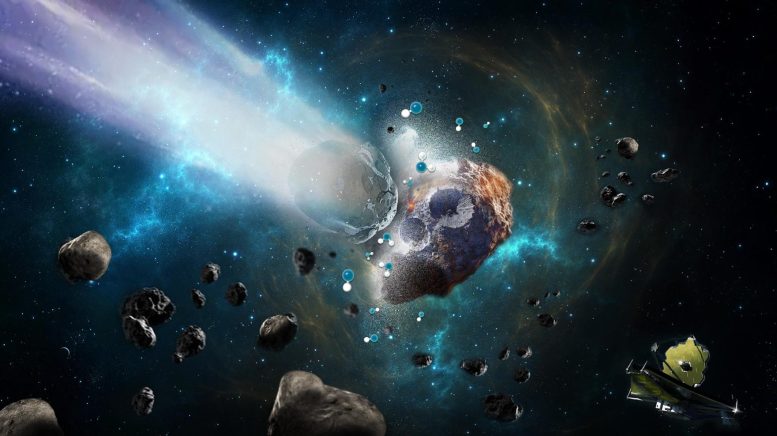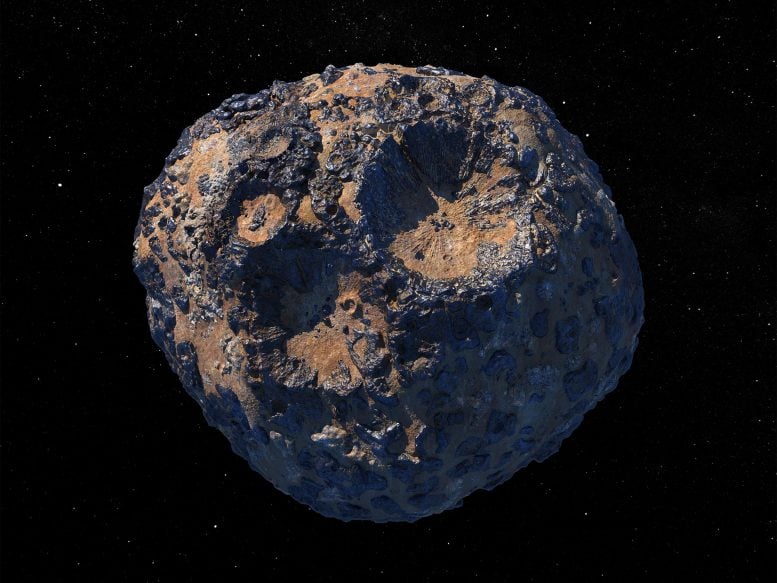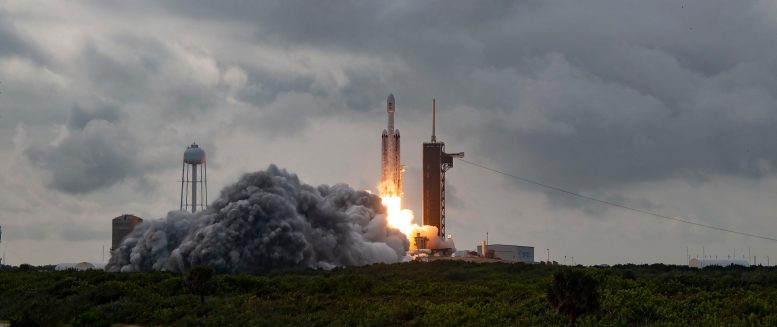
By Southwest Research Institute August 15, 2024
Collected at: https://scitechdaily.com/webb-telescope-uncovers-evidence-of-hydration-on-asteroid-psyche/
NASA’s Webb telescope has identified hydroxyl molecules on Psyche, a metallic asteroid, hinting at a more intricate history.
Psyche’s origin could challenge existing models, indicating it might have formed beyond the solar system’s “snow line.” This discovery will refine our understanding of asteroid compositions and water distribution in the solar system.
Discovery of Hydroxyl Molecules on Psyche
Using data from NASA’s James Webb Space Telescope, a Southwest Research Institute-led team has confirmed hydroxyl molecules on the surface of the metallic asteroid Psyche. The presence of hydrated minerals suggests a complex history for Psyche, important context for the NASA spacecraft en route to this interesting asteroid orbiting the Sun between Mars and Jupiter.

Psyche: A Massive Asteroid With a Mysterious Past
At about 140 miles in diameter, Psyche is one of the most massive objects in the main asteroid belt. Previous observations indicate that Psyche is a dense, largely metallic object that could be a leftover core from a planet that experienced a catastrophic collision. On October 13, 2023, NASA launched the Psyche spacecraft, which is traveling 2.2 billion miles to arrive at the asteroid in August 2029.
“Using telescopes at different wavelengths of infrared light, the SwRI-led research will provide different but complementary information to what the Psyche spacecraft is designed to study,” said SwRI’s Dr. Tracy Becker, second author of a new American Astronomical Society’s Planetary Science Journal paper discussing these findings.
Implications for Solar System Evolution
“Our understanding of solar system evolution is closely tied to interpretations of asteroid composition, particularly the M-class asteroids that contain higher concentrations of metal,” said Center for Astrophysics | Harvard & Smithsonian’s Dr. Stephanie Jarmak, the paper’s lead author, who conducted much of this research while at SwRI. “These asteroids were initially thought to be the exposed cores of differentiated planetesimals, a hypothesis based on their spectral similarity to iron meteorites.”

Hydrated Minerals and Psyche’s Complex History
The Webb data point to hydroxyl and perhaps water on Psyche’s surface. The hydrated minerals could result from external sources, including impactors. If the hydration is native or endogenous, then Psyche may have a different evolutionary history than current models suggest.
“Asteroids are leftovers from the planetary formation process, so their compositions vary depending on where they formed in the solar nebula,” said SwRI’s Dr. Anicia Arredondo, another co-author. “Hydration that is endogenous could suggest that Psyche is not the remnant core of a protoplanet. Instead, it could suggest that Psyche originated beyond the ‘snow line,’ the minimum distance from the Sun where protoplanetary disc temperatures are low enough for volatile compounds to condense into solids, before migrating to the outer main belt.”
However, the paper found the variability in the strength of the hydration features across the observations implies a heterogeneous distribution of hydrated minerals. This variability suggests a complex surface history that could be explained by impacts from carbonaceous chondrite asteroids thought to be very hydrated.
Broad Implications for Water Distribution in the Solar System
Understanding the location of asteroids and their compositions tells us how materials in the solar nebula were distributed and have evolved since formation. How water is distributed in our solar system will provide insight into the distribution of water in other solar systems and, because water is necessary for all life on Earth, will drive where to look for potential life, both in our solar system and beyond.
Reference: “Estimate of water and hydroxyl abundance on asteroid (16) Psyche from JWST data” by Stephanie G. Jarmak, Tracy M. Becker, Charles E. Woodward, Casey I. Honniball, Andrew S. Rivkin, Margaret M. McAdam, Zoe A. Landsman, Saverio Cambioni, Thomas G. Müller, Driss Takir, Kurt D. Retherford, Anicia Arredondo, Linda T. Elkins-Tanton, Planetary Science Journal.
arXiv:2407.12162
NASA’s Webb telescope, developed in partnership with the European and Canadian space agencies, is part of the Space Telescope Science Institute, operated by the Association of Universities for Research in Astronomy. The Psyche mission is led by Arizona State University. NASA’s Jet Propulsion Laboratory is responsible for mission management, operations, and navigation.

Leave a Reply